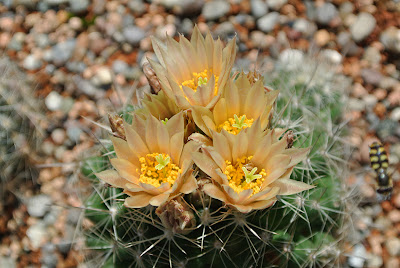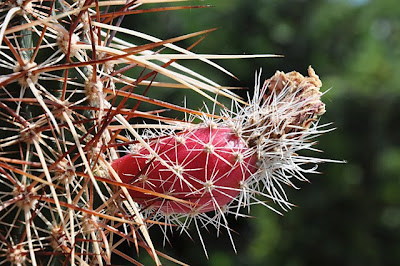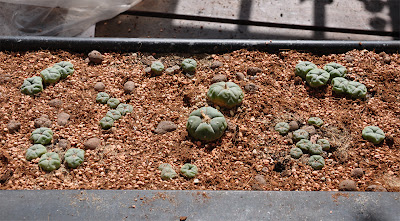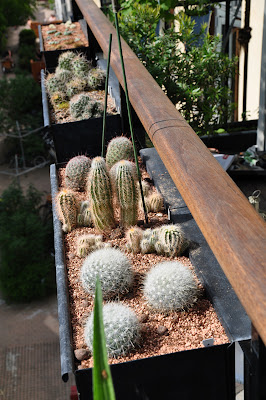
Snow covered cacti growing in window boxes
As mentioned in an earlier post I'm experimenting with growing peyote (and other cacti) outdoors on my balcony. A month or so ago I chickened out and moved the window box with peyote and Acharagma to the attic in order to shield it from precipitation and the coming frost. Today I'm glad I did as the balcony (and the flower boxes with it) has been completely covered in snow for the last couple of days - and I'm not sure if that would become the peyote plants well.

Echinocereus triglochidiatus covered by snow (with E. reichenbachii in the background)
I'm pretty sure that the hardy Echinocereus triglochidiatus will make it through the outdoor winter experience, and I'll also put money on the Escobaria vivipara (Alberta, Canada) and Escobaria missouriensis (SB204; Mesa County, Colorado) plants as they have already survived a winter outdoors, but I have my doubts about the Echinocereus reichenbachii plants as this is the first time I grow them under such extreme conditions.

Snow covered Mammillaria grahamii
Other doubts are regarding the Mammillaria grahamii (SB 1860; Steins, New Mexico, USA) and Mammillaria senilis (ROG 214; Tecorichi, Chihuahua, Mexico) plants as I'm very unsure if they are able to survive conditions like this. We'll know come spring.

Snow covered Mammillaria senilis
Thursday, January 30, 2014
Snow covered cacti on the balcony
Saturday, June 08, 2013
Growing peyote (and other cacti) on the balcony
40 peyote cacti growing in a window flower box
For the last many years I've experimented with growing peyote, Ariocarpus, Leuchtenbergia, and the likes in an unheated coldhouse in Denmark. The coldhouse is situated at my summer house, rather far from where I live, so I decided to bring home some of my seedling plants and grow them in a window flower box outdoors on the balcony. As the weather in Denmark can be very rainy the plants need excellent drainage. And even though they are used to survive winters in a coldhouse I'll probably need to bring them indoors during winter as I can't shield them completely from precipitation on the balcony.
Flower box planted with peyote and Acharagma
I waited for a sunny period (and a ditto long term weather report :-) before planting a window box with 40 peyote plants and a handful each of Acharagma aguirreana and Acharagma roseana plants.
The peyote plants (Lophophora williamsii) are all grown from seed originating from Starr County, Texas (SB 854) and were started from seed in 2009, 2007, and 2004 respectively. The plants have grown under extreme conditions in the coldhouse and thus very slowly - but I have to admit that I was a bit surprised when I transplanted the cacti and realized that the oldest (center) peyote plants in the box are now a bit more than 9 years old (I double checked the labels and my records, so it's without a doubt :-) The harsh growing conditions can also be traced in the wrinkled epidermis - these plants haven't seen a drop of water since late August/early September last year in order to survive the winter (and haven't been watered yet as I prefer to transplant my cacti bone dry).
Both Acharagma species were started from seed in spring 2009.
Drainage layer of Leca pebbles
I have never grown this type of cacti in window flower boxes before and was very much in doubt of what type of soil to use.
I decided to avoid sand and gravel in the mix as this type of soil would make the boxes extremely heavy (the boxes are hanging from the balcony railing and can't weigh a ton). Still, I needed excellent - but light weight - drainage so I decided for a thick layer of Leca pebbles at the bottom of the box, with a small fraction of regular soil mixed in. Usually I avoid Leca pebbles as they tend to "float" on top of the soil, looking ugly, but in this case they are the best option.
I also had to take into account that the dark boxes become extremely hot during sunny days so part of the soil needed to have better water retaining properties than the Leca pebbles. My solution was to use a top layer consisting of burnt moler cat litter and coir (a natural fibre extracted from the husk of coconut) - both are able to retain water but don't get soggy and waterlogged.
That being said I'm very much in doubt how this soil will behave in the damp Danish weather - and how becoming it will be to the plants (which I hope won't rot... but I'm sure time will tell :-)
Flower box planted with Echinocereus reichenbachii and Mammillaria
Another flower box was planted with Echinocereus reichenbachii originating from material I collected in the Wichita Mountains Wildlife Refuge back in 2007 plus a few Mammillaria grahamii (SB 1860; Steins, New Mexico, USA) and Mammillaria senilis (ROG 214; Tecorichi, Chihuahua, Mexico) plants bought from Kakteen-Haage.
I don't have much experience with growing Mammillaria species but selected these plants for their ability to tolerate cold conditions - and also for their beautiful flowers of course :-) One thing I learnt the hard way is that the fish hook spines of the Mammillaria plants behave like velcro when the plants get too close to each other, i.e. you should be very careful when planting several plants in the same container.
Three cacti window flower boxes on a row
I now have a total of three window flower boxes planted with cacti on the balcony; the two covered in this post plus the box planted with Echinocereus triglochidiatus, Escobaria vivipara (Alberta, Canada), and Escobaria missouriensis (SB204; Mesa County, Colorado). The latter box was planted last year and wintered outdoors on the balcony.
Sunday, January 27, 2013
Snow covered cacti on the balcony

Escobaria vivipara with a light snow cover
I’m fascinated by the ability of certain cacti species to survive even quite extreme freezing conditions. A fascination that is probably rooted in my childhood belief that all cacti were heat craving desert dwellers that would succumb to subfreezing temperatures - great was my surprise the first time I saw pictures of a cactus covered in snow.

Echinocereus triglochidiatus var. mojavensis sprinkled with snow
I live in a condominium and the only possibility for pursuing my interest in growing frost tolerant cacti outdoors - apart from the bed of winter-hardy cacti at my summerhouse - is to grow cacti in flower boxes on the balcony.
For several years I have successfully grown Echinocereus triglochidiatus (claret cup hedgehog cactus) outdoors (year-round) at my summerhouse in the northwestern part of Denmark - inspired by this I acquired a few E. triglochidiatus var. mojavensis (DJF1273; North of Inyo County, California) plants for my flower boxes a couple of years ago and they are also doing great.

Escobaria missouriensis in the snow
The well-being of the Escobaria species are of greater concern to me. The Botanical Garden of Copenhagen attempted growing Escobaria in their outdoor cactus bed but they all perished. My plants still seem to be weathering it out here in Copenhagen but I’m concerned that the continuous frost-thaw cycles will expose the plants to killing moisture.
Denmark has been frost-bound for several weeks now with the plants seeing temperatures as low as -10 C (14 F) (this is nothing for Escobaria vivipara which is known to have survived extreme temperatures as low as -35 degrees C) but the frost now loosens its grip again and it has started to rain, soaking the flower boxes that are still frozen solid. I hope that the light shelter provided by the balcony on the floor above will keep the plants from getting too wet - if not, I reckon the rot will soon show in the coming period of relatively warm and humid weather.
The beehive cactus species I’m growing in flower boxes on the balcony are Escobaria vivipara (Alberta, Canada) and Escobaria missouriensis (Mesa County, Colorado; SB204)

Flower box with Escobaria and Echinocereus cacti in the snow
This coming season I plan to grow peyote cactus in outdoor window boxes as well - but I don’t expect peyote to cope well with the Danish winter so the plants will need to be wintered in the attic.
Below are a few pictures of the balcony grown Escobaria plants during summer - what a happy flowering bunch :-)

Flowering Escobaria vivipara (Alberta, Canada)

Flowering Escobaria missouriensis (Mesa County, Colorado; SB204)
In relation to the two above images, the previous post featured a high-speed video showing the flower fly hovering above the Escobaria vivipara cactus.
Monday, March 15, 2010
Echinocereus engelmannii v. armatus - flower and fruit
My Echinocereus engelmannii v. armatus (Joshua Tree National Park, California) flowered for the first time in the late spring of ‘09.
Echinocereus engelmannii v. armatus flower, close-up
The flower was beautiful with bright yellow anthers, a mesmerizing green stigma, and petals ranging from intensive pink to almost crimson at the center of the flower.
Flowering Echinocereus engelmannii v. armatus
The plant easily lives up to its varietal name - even the flower stalk is heavily armed with spines, protecting the ovary and the coming fruit.
Echinocereus engelmannii v. armatus flower armed with spines
I hand-pollinated the flower and two months later the plant bore fruit. This is the only mature Echinocereus engelmannii v. armatus in my collection and no other Echinocereus plants flowered at the time so my E. engelmannii v. armatus seems to be self-fertile. Time will tell if the seeds are viable.
Echinocereus engelmannii v. armatus with fruit
Echinocereus engelmannii v. armatus with fruit, top view
Wednesday, May 14, 2008
Flowering Echinocereus reichenbachii
I have been growing Echinocereus reichenbachii in my coldhouse for a while but never seen any flowers until last week. Several of the plants flowered for the first time - an impressive sight.
Flowering Echinocereus reichenbachii
The flowers are excessively beautiful with their silvery pink to magenta petals, bright yellow anthers, and the fresh green stigma in the center of it all.
Echinocereus reichenbachii flower, close-up
The flowers seem rather variable both in the number and color of the petals. The flower pictured below has fewer, larger, and darker petals than the one above.
E. reichenbachii flower with a slightly darker hue
I outcrossed the flowers and hope for seeds next year.
Sunday, September 23, 2007
In search of Echinocereus reichenbachii in Wichita Mountains Wildlife Refuge
I recently revisited Oklahoma City. Having heard that Echinocereus reichenbachii is abundant in the millions in Oklahoma, I decided to see if I could find some of these fascinating plants in habitat where they occur in many stem forms and spine colors. E. reichenbachii grows in several of the state parks in western Oklahoma, but after a bit of research I decided on visiting the Wichita Mountains Wildlife Refuge. The refuge is within easy driving distance from OKC (head southwest on highway 44 for an hour or so, then take the Medicine Park exit just north of Lawton) and apart from cacti it also boasts a rare remnant mixed grass prairie, an island where the natural grasslands escaped destruction thanks to the granite outcrops rendering the land impossible to plow.

A cluster of Echinocereus reichenbachii var. albispinus
All the Echinocereus plants I found were of the variety Echinocereus reichenbachii var. albispinus (or Echinocereus baileyi if you consider it a full species). It seems like the plants prefer to grow in fissures in the granitic rock, especially if moss is also growing in the fissures.

E. reichenbachii var. albispinus growing in moss
The pictured plants are growing in the open prairie grasslands south-east of Mount Scott. It’s quite amazing that most of the plants seem undamaged by the grazing herds of bison and longhorn; I would expect such a large animal could trample an Echinocereus underfoot without even noticing it, but that doesn’t seem to be the case.

Grazing bison
I also saw a few Opuntia plants – probably O. phaeacantha – with beautiful carmine-red fruits. The pictured plant is growing on the southern bank of Quanah Parker Lake; named for the Quanah Parker of Native American Church fame.

Fruiting Opuntia sp. (O. phaeacantha?)
The Wichita Mountains Wildlife Refuge is a very interesting place to visit and I wish I had had more time (unfortunately I had to deal with delayed baggage, limiting the visit to half a day). It comes highly recommended if you are looking for Echinocereus reichenbachii var. albispinus (= Echinocereus baileyi) or bison ;-)
You can find more photos from my visit at http://public.fotki.com/WichitaMountainsWR/.
All Time Most Popular Posts
-
Lophophora williamsii (peyote) populations have diminished in large areas of South Texas where peyoteros harvest the cactus for ceremonial ...
-
On various occasions I've been asked what growing media I'm using for my cactus plants. I don't have a set soil mix recipe as su...
-
Below is a list of retailers/nurseries selling cactus seed and plants. I've only listed vendors I've done business with. If you ar...
-
Most cacti are easily grown from seed - and with a little patience and care they can be grown into beautiful plants. Lophophora williamsi...
-
In last month’s post on the troubled Texan peyoteros I referred to Anderson’s article on the peyote situation in Texas. Given the importanc...
-
Yet another slightly off topic and probably not entirely politically correct post, but I couldn’t help noticing the similarity of my monstr...
-
Flowering stand of San Pedro cacti (Trichocereus pachanoi) To me the main draw of the San Pedro cactus ( Trichocereus pachanoi (syn. Ech...
-
In the June 2008 issue of the Cactus & Co magazine Jaroslav Šnicer, Jaroslav Bohata, and Vojtěch Myšák described a new Lophophora spec...
-
There seems to be an increased focus on the alarming Texas peyote situation. A couple of weeks ago the Houston Press published a mournful, i...
-
I spent two weeks working in Delhi, India during January. I had one weekend off and had planned to spend it in Delhi at my own leisure, but ...























